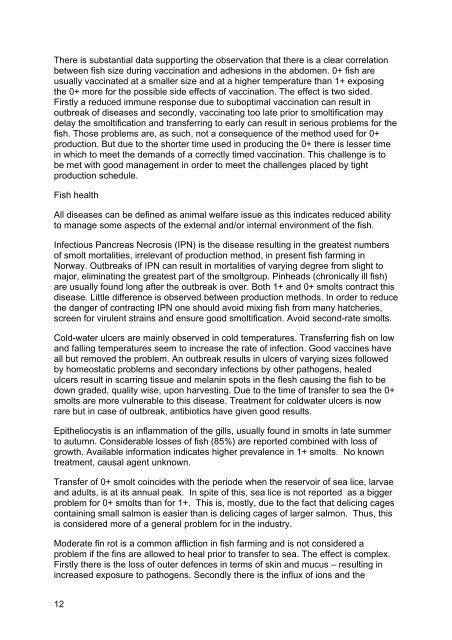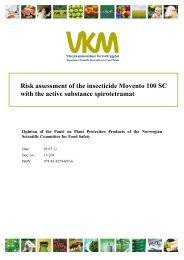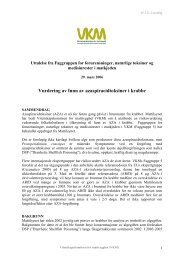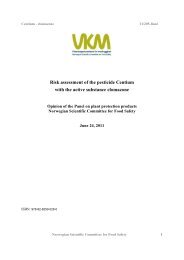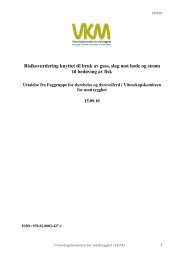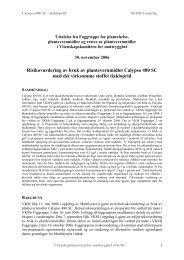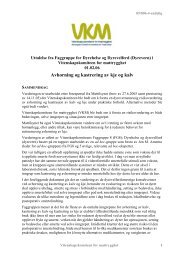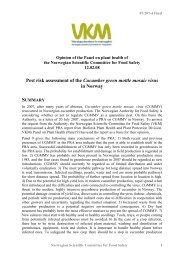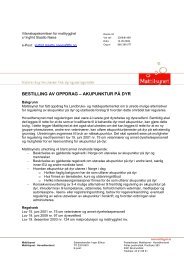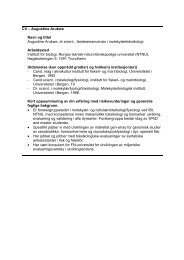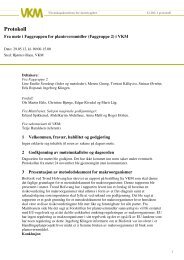Fiskevelferdsmessig vurdering av produksjon av 0-års smolt
Fiskevelferdsmessig vurdering av produksjon av 0-års smolt
Fiskevelferdsmessig vurdering av produksjon av 0-års smolt
Create successful ePaper yourself
Turn your PDF publications into a flip-book with our unique Google optimized e-Paper software.
There is substantial data supporting the observation that there is a clear correlation<br />
between fish size during vaccination and adhesions in the abdomen. 0+ fish are<br />
usually vaccinated at a smaller size and at a higher temperature than 1+ exposing<br />
the 0+ more for the possible side effects of vaccination. The effect is two sided.<br />
Firstly a reduced immune response due to suboptimal vaccination can result in<br />
outbreak of diseases and secondly, vaccinating too late prior to <strong>smolt</strong>ification may<br />
delay the <strong>smolt</strong>ification and transferring to early can result in serious problems for the<br />
fish. Those problems are, as such, not a consequence of the method used for 0+<br />
production. But due to the shorter time used in producing the 0+ there is lesser time<br />
in which to meet the demands of a correctly timed vaccination. This challenge is to<br />
be met with good management<br />
in order to meet the challenges placed by tight<br />
production schedule.<br />
Fish health<br />
All diseases can be defined as animal welfare issue as this indicates reduced ability<br />
to manage some aspects of the external and/or internal environment of the fish.<br />
Infectious Pancreas Necrosis (IPN) is the disease resulting in the greatest numbers<br />
of <strong>smolt</strong> mortalities, irrelevant of production method, in present fish farming in<br />
Norway. Outbreaks of IPN can result in mortalities of varying degree from slight to<br />
major, eliminating the greatest part of the <strong>smolt</strong>group. Pinheads (chronically ill fish)<br />
are usually found long after the outbreak is over. Both 1+ and 0+ <strong>smolt</strong>s contract this<br />
disease. Little difference is observed between production methods. In order to reduce<br />
the danger of contracting IPN one should <strong>av</strong>oid mixing fish from many hatcheries,<br />
screen for virulent strains and ensure good <strong>smolt</strong>ification. Avoid second-rate <strong>smolt</strong>s.<br />
Cold-water ulcers are mainly observed in cold temperatures. Transferring fish on low<br />
and falling temperatures seem to increase the rate of infection. Good vaccines h<strong>av</strong>e<br />
all but removed the problem. An outbreak results in ulcers of varying sizes followed<br />
by homeostatic problems and secondary infections by other pathogens, healed<br />
ulcers result in scarring tissue and melanin spots in the flesh causing the fish to be<br />
down graded, quality wise, upon harvesting. Due to the time of transfer to sea the 0+<br />
<strong>smolt</strong>s are more vulnerable to this disease. Treatment for coldwater<br />
ulcers is now<br />
rare but in case of outbreak, antibiotics h<strong>av</strong>e given good results.<br />
Epitheliocystis is an inflammation of the gills, usually found in <strong>smolt</strong>s in late summer<br />
to autumn. Considerable losses of fish (85%) are reported combined with loss of<br />
growth. Available information indicates<br />
higher prevalence in 1+ <strong>smolt</strong>s. No known<br />
treatment, causal agent unknown.<br />
Transfer of 0+ <strong>smolt</strong> coincides with the periode when the reservoir of sea lice, larvae<br />
and adults, is at its annual peak. In spite of this, sea lice is not reported as a bigger<br />
problem for 0+ <strong>smolt</strong>s than for 1+. This is, mostly, due to the fact that delicing cages<br />
containing small salmon is easier than is delicing cages of larger<br />
salmon. Thus, this<br />
is considered more of a general problem for in the industry.<br />
Moderate fin rot is a common affliction in fish farming and is not considered a<br />
problem if the fins are allowed to heal prior to transfer to sea. The effect is complex.<br />
Firstly there is the loss of outer defences in terms of skin and mucus – resulting in<br />
increased exposure to pathogens. Secondly there is the influx of ions and the<br />
12


